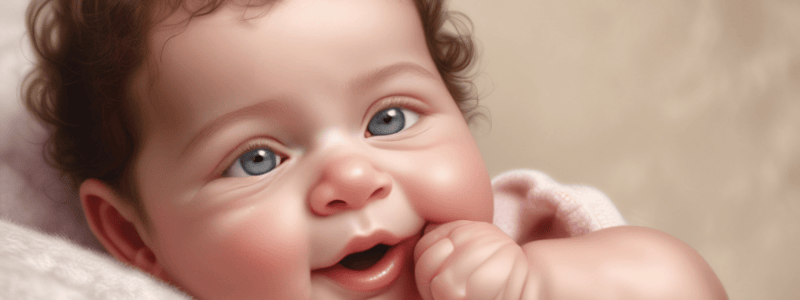Podcast
Questions and Answers
What is the average pulse rate of neonates within the first half hour after birth?
What is the average pulse rate of neonates within the first half hour after birth?
At what age does the respiratory rate of infants usually fall to 30-40 breaths per minute?
At what age does the respiratory rate of infants usually fall to 30-40 breaths per minute?
How much weight loss is considered normal for neonates in the first week after birth?
How much weight loss is considered normal for neonates in the first week after birth?
What is a common issue faced by neonates due to their primary mode of respiration involving nose breathing?
What is a common issue faced by neonates due to their primary mode of respiration involving nose breathing?
Signup and view all the answers
Which reflex allows for the molding of an infant's head before the skull bones fuse?
Which reflex allows for the molding of an infant's head before the skull bones fuse?
Signup and view all the answers
Study Notes
- Neonates and infants (1 month to 1 year) undergo rapid physical development, with pulse rate decreasing from 90-205 to around 120 beats per minute within the first half hour after birth, and respiratory rate falling from 30-60 to 30-40 breaths per minute by age 1 year.
- Blood pressure in neonates corresponds directly with weight, with systolic pressure ranging from 67-84 at birth to 85-104 by one year of age.
- Neonates usually weigh 6 to 8 pounds at birth, with their head accounting for about 25% of their body weight, and they may lose 5 to 10% of their birth weight in the first week due to fluid loss.
- Neonates have a pulmonary system that primarily involves nose breathing, making them prone to nasal congestion and upper respiratory infections, with fewer alveoli in the lungs for gas exchange.
- Infants are born with certain reflexes like the Moro reflex, Palmer grasp, and rooting reflex, and they have fontanels that allow their heads to be molded before the bones fuse into a skull.
Studying That Suits You
Use AI to generate personalized quizzes and flashcards to suit your learning preferences.
Description
Test your knowledge on the rapid physical development of neonates and infants, including changes in pulse rate, respiratory rate, blood pressure, weight, and reflexes. Learn about the unique pulmonary system of neonates and the fontanels present in infants.




